Semiconductor equipment maker Lam Research (NASDAQ:LCRX) reported results ahead of analysts' expectations in Q1 CY2024, with revenue down 2% year on year to $3.79 billion. The company expects next quarter's revenue to be around $3.8 billion, in line with analysts' estimates. It made a non-GAAP profit of $7.79 per share, improving from its profit of $6.99 per share in the same quarter last year.
Lam Research (LRCX) Q1 CY2024 Highlights:
- Revenue: $3.79 billion vs analyst estimates of $3.73 billion (1.7% beat)
- EPS (non-GAAP): $7.79 vs analyst estimates of $7.30 (6.8% beat)
- Revenue Guidance for Q2 CY2024 is $3.8 billion at the midpoint, roughly in line with what analysts were expecting
- Gross Margin (GAAP): 47.5%, up from 43.2% in the same quarter last year
- Inventory Days Outstanding: 197, down from 203 in the previous quarter
- Free Cash Flow of $1.28 billion, similar to the previous quarter
- Market Capitalization: $116.3 billion
Founded in 1980 by David Lam, who pioneered semiconductor etching technology, Lam Research (NASDAQ:LCRX) is one of the leading providers of the wafer fabrication equipment used to make semiconductors.
Lam Research is one of a handful of companies in the world that makes the tools used in deposition, etching, and cleaning wafers. It has a concentrated customer base made up of the biggest chip makers in the world like TSMC, Intel, Samsung and Micron. Its biggest customer base are the producers of memory chips, which have traditionally accounted for about two thirds of Lam’s revenues.
Specifically, Lam’s tools are heavily used in the production of NAND memory, which has evolved into more complex 3D designs over the past few years, requiring more complex tools to etch and deposit more structures on ever shrinking memory chips. In the long run, DRAM will likely shift to 3D designs, providing an opportunity for Lam. Because Lam is so exposed to memory chips, which have the most volatile pricing within semiconductors, Lam’s model tends to be more volatile than its tool maker peers, such as Applied Materials or ASML.
Its primary peers and competitors are Applied Materials, (NASDAQ:AMAT), ASML (NASDAQ:ASML), KLA Corp (NASDAQ:KLAC), and Samsung Electronics (KOSE:005930).Semiconductor Manufacturing
The semiconductor capital (manufacturing) equipment group has become highly concentrated over the past decade. Suppliers have consolidated, and the increasing cost of innovation have made it unaffordable to almost everybody, except the largest companies, to produce leading edge chips. The result of the increased industry concentration has been higher operating margins and free cash generation through the cycle. Despite this structural improvement, the businesses can still be quite volatile, as demand fluctuations for the semiconductor equipment are magnified by the already cyclical nature of underlying semiconductor demand.
Sales Growth
Lam Research's revenue growth over the last three years has been unimpressive, averaging 5.7% annually. This quarter, its revenue declined from $3.87 billion in the same quarter last year to $3.79 billion. Semiconductors are a cyclical industry, and long-term investors should be prepared for periods of high growth followed by periods of revenue contractions (which can sometimes offer opportune times to buy).
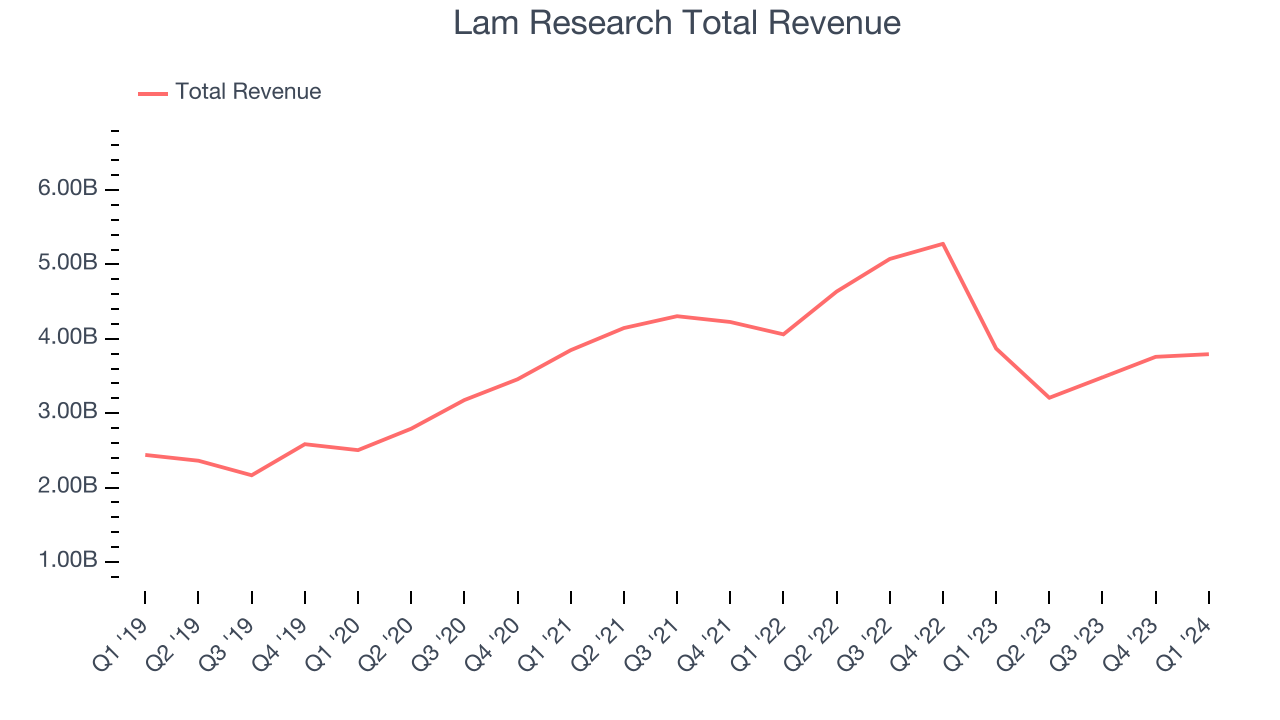
Even though Lam Research surpassed analysts' revenue estimates, this was a slow quarter for the company as its revenue dropped 2% year on year. This could mean that the current downcycle is deepening.
Lam Research looks like it's on the cusp of a rebound, as it's guiding to 18.5% year-on-year revenue growth for the next quarter. Analysts seem to agree as consesus estimates call for 16.3% growth over the next 12 months.
Product Demand & Outstanding Inventory
Days Inventory Outstanding (DIO) is an important metric for chipmakers, as it reflects a business' capital intensity and the cyclical nature of semiconductor supply and demand. In a tight supply environment, inventories tend to be stable, allowing chipmakers to exert pricing power. Steadily increasing DIO can be a warning sign that demand is weak, and if inventories continue to rise, the company may have to downsize production.
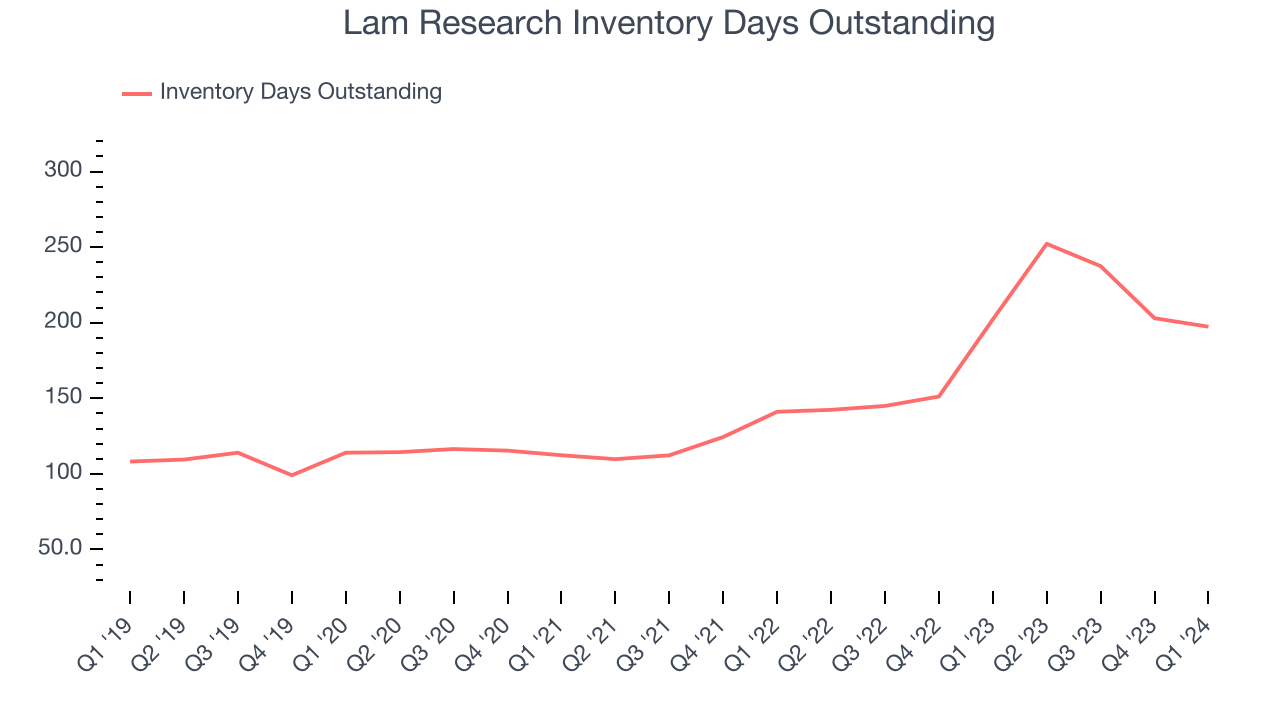
This quarter, Lam Research's DIO came in at 197, which is 52 days above its five-year average. These numbers suggest that despite the recent decrease, the company's inventory levels are higher than what we've seen in the past.
Pricing Power
In the semiconductor industry, a company's gross profit margin is a critical metric to track because it sheds light on its pricing power, complexity of products, and ability to procure raw materials, equipment, and labor. Lam Research's gross profit margin, which shows how much money the company gets to keep after paying key materials, input, and manufacturing costs, came in at 47.5% in Q1, up 4.2 percentage points year on year.
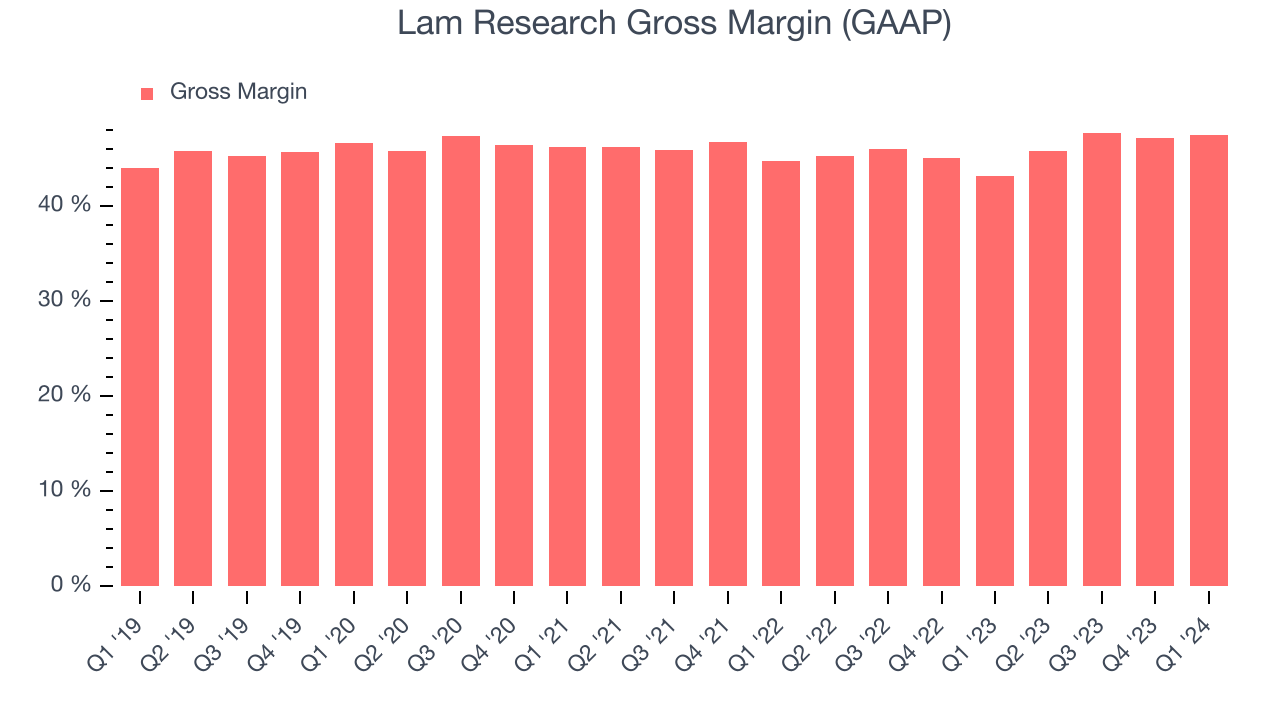
Lam Research's gross margins have been trending up over the last 12 months, averaging 47.1%. This is a welcome development, as Lam Research's margins are slightly below the peer group average and rising margins could suggest improved demand and pricing power.
Profitability
Lam Research reported an operating margin of 30.3% in Q1, up 2 percentage points year on year. Operating margins are one of the best measures of profitability because they tell us how much money a company takes home after manufacturing its products, marketing and selling them, and, importantly, keeping them relevant through research and development.
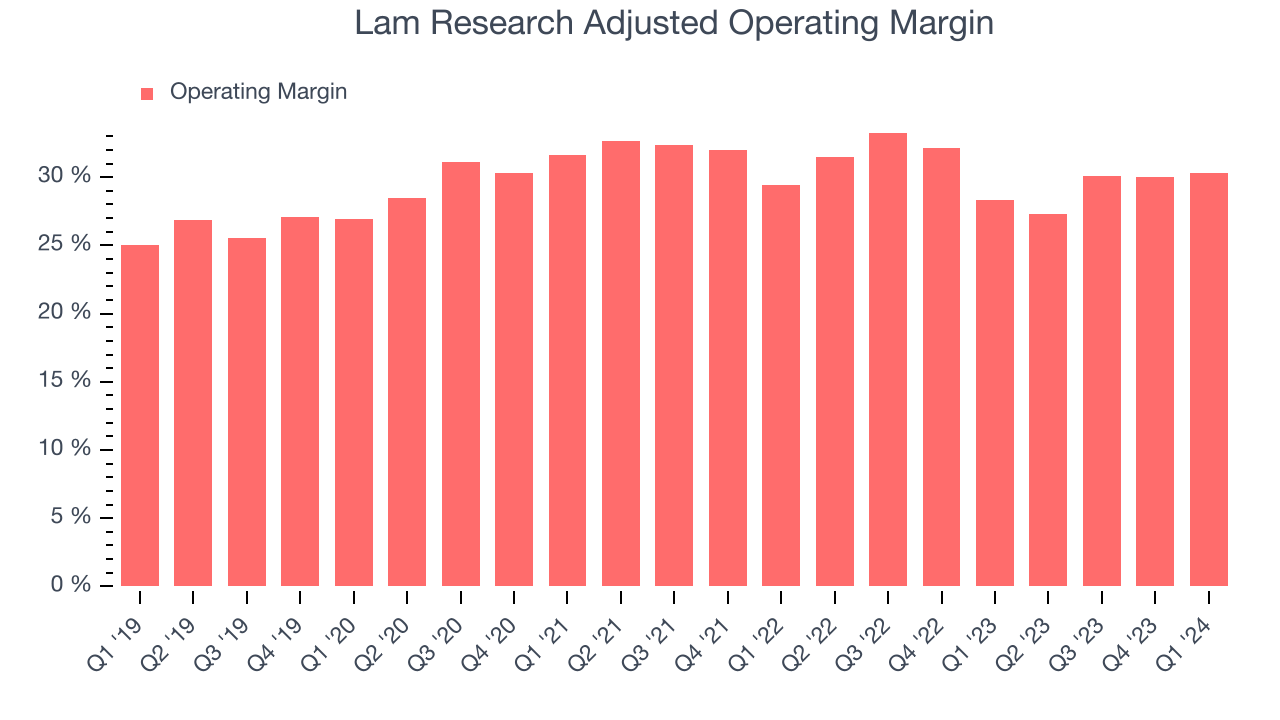
Lam Research's operating margins have been trending down over the last year, averaging 29.5%. The company's profitability is in line with the broader semiconductor industry and it's working to appropriately manage its operating expenses.
Earnings, Cash & Competitive Moat
Analysts covering Lam Research expect earnings per share to grow 18.2% over the next 12 months, although estimates will likely change after earnings.
Although earnings are important, we believe cash is king because you can't use accounting profits to pay the bills. Lam Research's free cash flow came in at $1.28 billion in Q1, down 20.3% year on year.
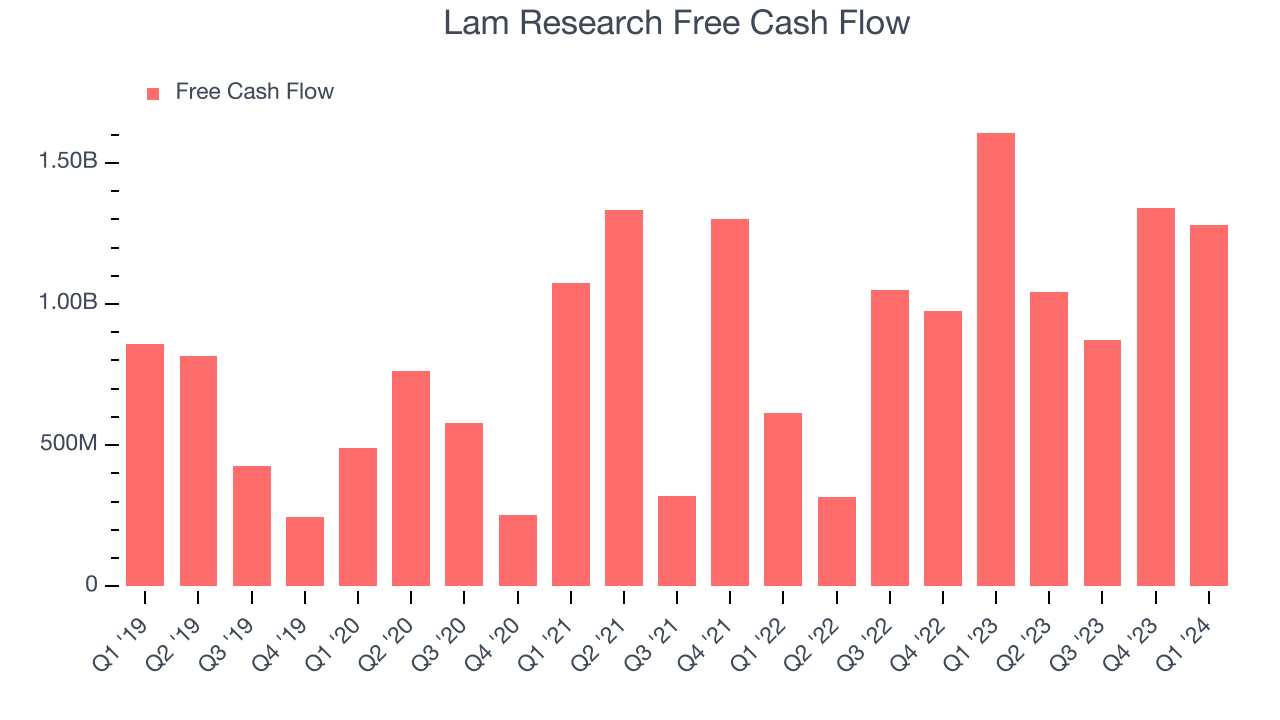
As you can see above, Lam Research produced $4.54 billion in free cash flow over the last 12 months, an eye-popping 31.9% of revenue. This is a great result; Lam Research's free cash flow conversion places it among the best semiconductor companies and, if sustainable, puts the company in an advantageous position to invest in new products while remaining resilient during industry downturns.
Return on Invested Capital (ROIC)
EPS and free cash flow tell us whether a company was profitable while growing revenue. But was it capital-efficient? A company’s ROIC explains this by showing how much operating profit a company makes compared to how much money the business raised (debt and equity).
Lam Research's five-year average ROIC was 64.3%, placing it among the best semiconductor companies. Just as you’d like your investment dollars to generate returns, Lam Research's invested capital has produced excellent profits.
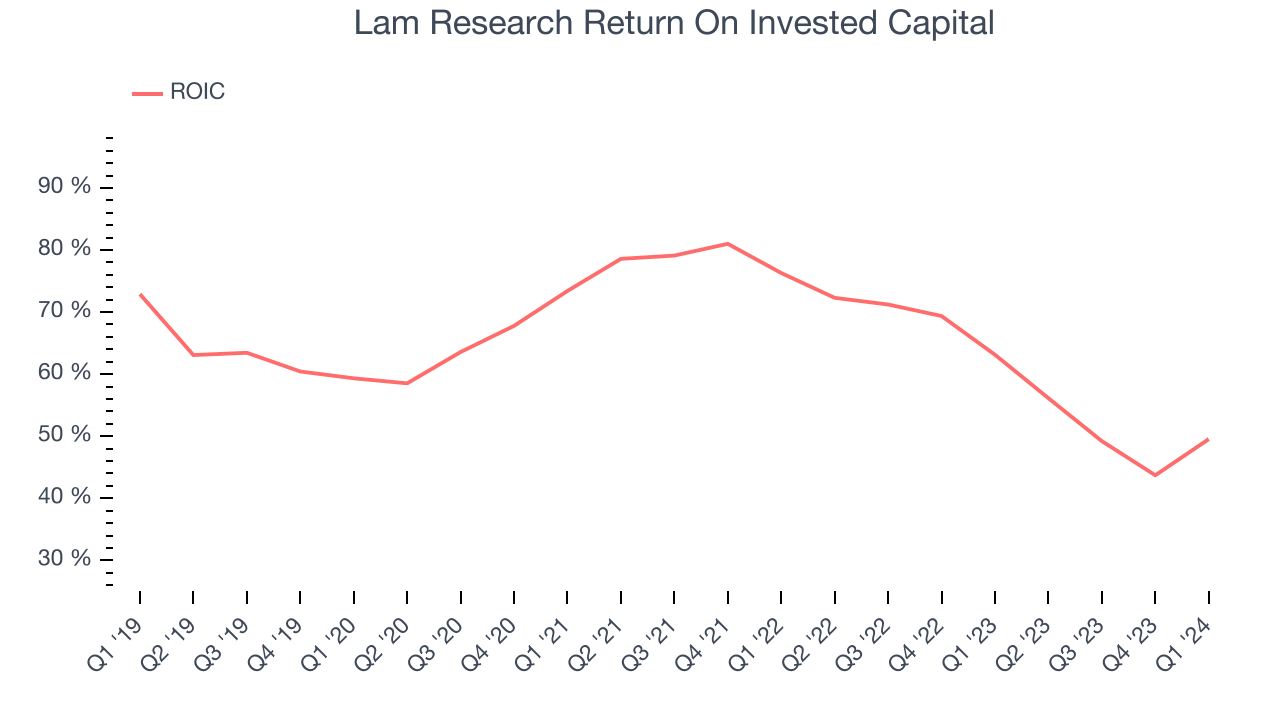
The trend in its ROIC, however, is often what surprises the market and drives the stock price. Unfortunately, Lam Research's ROIC averaged 10 percentage point decreases over the last few years. The company has historically shown the ability to generate good returns, but they have gone the wrong way recently, making us a bit conscious.
Balance Sheet Risk
As long-term investors, the risk we care most about is the permanent loss of capital. This can happen when a company goes bankrupt or raises money from a disadvantaged position and is separate from short-term stock price volatility, which we are much less bothered by.
Lam Research is a well-capitalized company with $5.67 billion of cash and $4.98 billion of debt, meaning it could pay back all its debt tomorrow and still have $688.8 million of cash on its balance sheet. This net cash position gives Lam Research the freedom to raise more debt, return capital to shareholders, or invest in growth initiatives.
Key Takeaways from Lam Research's Q1 Results
We liked how Lam Research's beat on revenue and EPS as well as showing solid gross margin improvement this quarter. That the company guided revenue for next quarter in line with expectations shows that the company is on track. Overall, we think this was a fine quarter. The stock is flat after reporting and currently trades at $885 per share.
Is Now The Time?
When considering an investment in Lam Research, investors should take into account its valuation and business qualities as well as what's happened in the latest quarter.
There are several reasons why we think Lam Research is a great business. Although its revenue growth has been weak over the last three years with analysts expecting growth to slow from here, its powerful free cash generation enables it to sustainably invest in growth initiatives while maintaining an ample cash cushion. On top of that, its stellar ROIC suggests it has been a well-run company historically.
Lam Research's price-to-earnings ratio based on the next 12 months is 26.6x. Looking at the semiconductors landscape today, Lam Research's qualities stand out, and we like the stock at this price.
Wall Street analysts covering the company had a one-year price target of $958.54 per share right before these results (compared to the current share price of $885), implying they saw upside in buying Lam Research in the short term.
To get the best start with StockStory check out our most recent Stock picks, and then sign up to our earnings alerts by adding companies to your watchlist here. We typically have the quarterly earnings results analyzed within seconds of the data being released, and especially for the companies reporting pre-market, this often gives investors the chance to react to the results before the market has fully absorbed the information.
